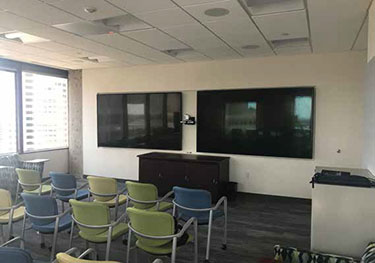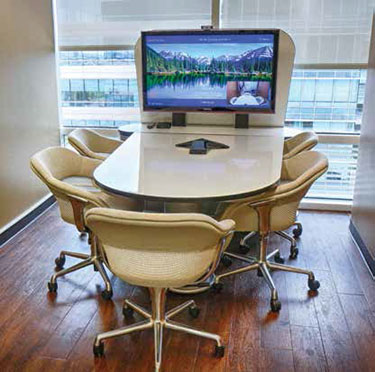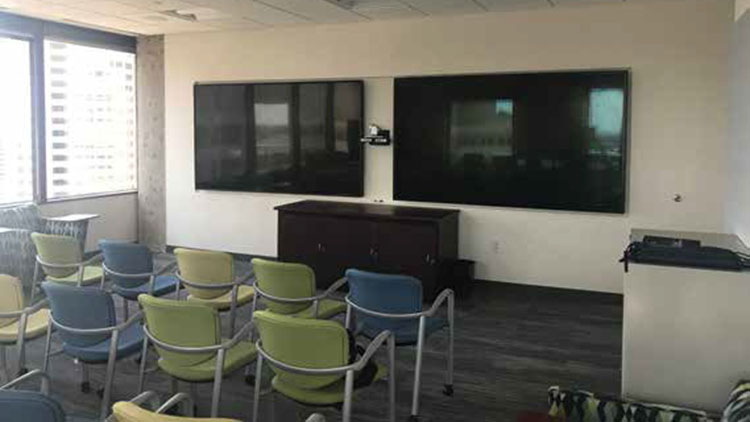United we stand—it’s not just about loving your country. That’s also true in business, with its heightened awareness of how updated unified communications (UC) systems can lift the bottom line.
When Houston, TX-based AV company Data Projections heard from a longtime client about helming a thorough UC upgrade, they learned an eye-popping metric: The customer, a large insurance/financial corporation headquartered in Texas, had determined their employees’ collective lost time due to meeting-based delays—several minutes per meeting—was costing them $200,000 per day.
“People took time trying to figure out where to call into, how to get the technology in the room working, and how to get everybody on the call before they actually begin the meeting,” said Robby Turner, executive vice president of sales and marketing for Data Projections. “Take those minutes and extrapolate them across the number of meetings that they had on a typical day—the lost revenue and productivity was significant.”
UC is the integration of many enterprise communication solutions—IM, presence information, mobility, AV conferencing, voicemail, email, and more—aiming toward a consistent user experience across all those platforms. But simply converging them under one roof is only half the battle.
“Data Projections thinks of UC as, ‘How do we bring all of those together on one platform in a way that makes it easy for the customer or end user?’” Turner said. “We’ve seen increasing innovation, and therefore expectations, for UC over the last 10 years. When we saw it truly happening is when Microsoft’s Skype for Business came to the forefront, and was adopted by the corporate market.”
Turner likens quality UC to the seemingly simple act of completing a call. “I compare it to my cell phone: It doesn’t matter that I’ve got an iPhone and I’m on Verizon, and you’ve got a Samsung Galaxy and you’re on AT&T. I’m going to hit your number in my address book and it’s going to call you and we’re going to talk.
“That’s how easy it should be. Whatever interface that you’re using for meetings, whether you’re on the road, in the hotel, in the airport, or at your home office, or in the corporate office boardroom, you’re going to hit it and join it. That saves time and money. It reduces the time that it takes to make those mission-critical and day-to-day decisions—that product or solution gets to market that much quicker.”

Data Projections upgraded a client’s offices with a UC system based around Skype for Business, with the aim of both unifying communications and making them easier.
Data Projections’ long history with the client helped in thoroughly evaluating their current system, and devising a way forward. “They had all these different solutions, but they didn’t have a true unified communications platform,” Turner said. “Their legacy direction had been Cisco, but ultimately they made the decision that they wanted to go the Skype for Business path, not only to unify those communications but to make them easy: that one-touch join from your mobile device, laptop, desktop, into the huddle space to the boardroom, to the training room, across the enterprise.
“This is where Polycom’s partnership with Microsoft comes in, and the easy, one-touch join,” Turner said. “That was the driving decision behind the direction we went with them. It was a process that included trips with their management to the Polycom Executive Experience Center in Austin, where they could see the power of Microsoft and Polycom, and all the R&D that was going on.”
Many solutions are deployed across the company’s enterprise, varying in degrees of integration with other platforms, with certification for Skype for Business and Office365 considered essential. These include Polycom Group Series and Polycom RealPresence Clarity videoconferencing solutions, in an infrastructure integrated with their Skype For Business on-premises server environment. Polycom Centro and Polycom Medialign video collaboration solutions are on site, as well as Polycom Trio conference phones. Shure ceiling mics cover sound with multiple arrays, all of it controlled by Crestron interactive flat panels.

The company’s new UC solution is a combination of physical gear—such as huddle spaces—and cloud services.
Put together, the company’s new UC is a hybrid of physical gear and cloud solutions. “Their plan is to transition to Office365 eventually,” Turner said, “and that’s what we’re seeing with a lot of our large, enterprise corporate customers. They’re giving up that control, but now they can put it offsite so that they don’t have to manage it.”
The way Data Projections sees it, delivering the best UC calls for systems contractors to ask the right questions, first and foremost. “It’s really about the conversation with the customer, and learning what their direction is,” Turner said. “We have to understand what their IT goals are. Do they have the staff with the knowledge that is needed to manage an on-premises solution? If not, do they plan on acquiring that staff, or are they looking to do more of pushing that to the cloud? Are they currently using Skype for Business? Do they currently have any existing infrastructure or bridging solutions? UC comes down to understanding what your client’s goals are as an organization, and making everything easy to use.”
David Weiss (dwords.com) writes extensively about AV, audio, and broadcast technology.
